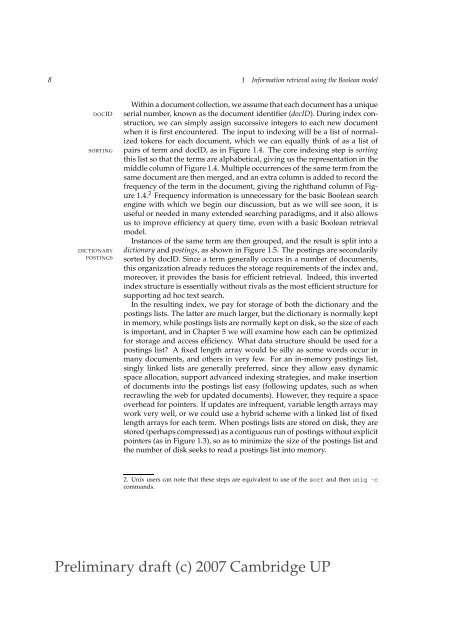Preliminary draft (c) 2007 Cambridge UP - Villanova University
Preliminary draft (c) 2007 Cambridge UP - Villanova University
Preliminary draft (c) 2007 Cambridge UP - Villanova University
Create successful ePaper yourself
Turn your PDF publications into a flip-book with our unique Google optimized e-Paper software.
8 1 Information retrieval using the Boolean model<br />
DOCID<br />
SORTING<br />
DICTIONARY<br />
POSTINGS<br />
Within a document collection, we assume that each document has a unique<br />
serial number, known as the document identifier (docID). During index construction,<br />
we can simply assign successive integers to each new document<br />
when it is first encountered. The input to indexing will be a list of normalized<br />
tokens for each document, which we can equally think of as a list of<br />
pairs of term and docID, as in Figure 1.4. The core indexing step is sorting<br />
this list so that the terms are alphabetical, giving us the representation in the<br />
middle column of Figure 1.4. Multiple occurrences of the same term from the<br />
same document are then merged, and an extra column is added to record the<br />
frequency of the term in the document, giving the righthand column of Figure<br />
1.4. 2 Frequency information is unnecessary for the basic Boolean search<br />
engine with which we begin our discussion, but as we will see soon, it is<br />
useful or needed in many extended searching paradigms, and it also allows<br />
us to improve efficiency at query time, even with a basic Boolean retrieval<br />
model.<br />
Instances of the same term are then grouped, and the result is split into a<br />
dictionary and postings, as shown in Figure 1.5. The postings are secondarily<br />
sorted by docID. Since a term generally occurs in a number of documents,<br />
this organization already reduces the storage requirements of the index and,<br />
moreover, it provides the basis for efficient retrieval. Indeed, this inverted<br />
index structure is essentially without rivals as the most efficient structure for<br />
supporting ad hoc text search.<br />
In the resulting index, we pay for storage of both the dictionary and the<br />
postings lists. The latter are much larger, but the dictionary is normally kept<br />
in memory, while postings lists are normally kept on disk, so the size of each<br />
is important, and in Chapter 5 we will examine how each can be optimized<br />
for storage and access efficiency. What data structure should be used for a<br />
postings list? A fixed length array would be silly as some words occur in<br />
many documents, and others in very few. For an in-memory postings list,<br />
singly linked lists are generally preferred, since they allow easy dynamic<br />
space allocation, support advanced indexing strategies, and make insertion<br />
of documents into the postings list easy (following updates, such as when<br />
recrawling the web for updated documents). However, they require a space<br />
overhead for pointers. If updates are infrequent, variable length arrays may<br />
work very well, or we could use a hybrid scheme with a linked list of fixed<br />
length arrays for each term. When postings lists are stored on disk, they are<br />
stored (perhaps compressed) as a contiguous run of postings without explicit<br />
pointers (as in Figure 1.3), so as to minimize the size of the postings list and<br />
the number of disk seeks to read a postings list into memory.<br />
2. Unix users can note that these steps are equivalent to use of the sort and then uniq -c<br />
commands.<br />
<strong>Preliminary</strong> <strong>draft</strong> (c)<strong>2007</strong> <strong>Cambridge</strong> <strong>UP</strong>



